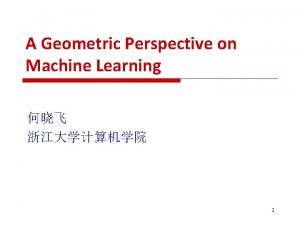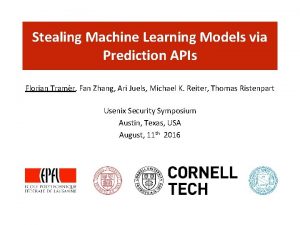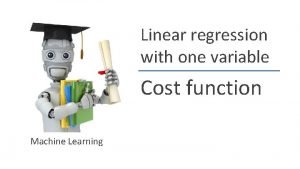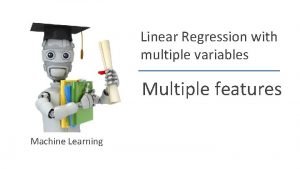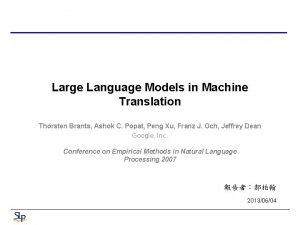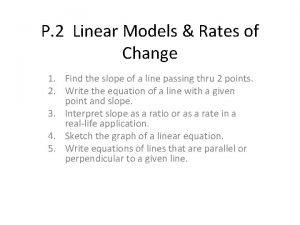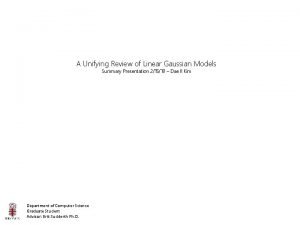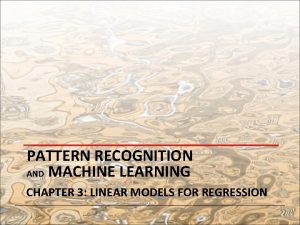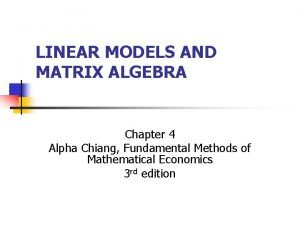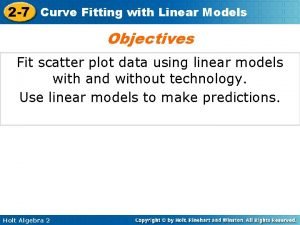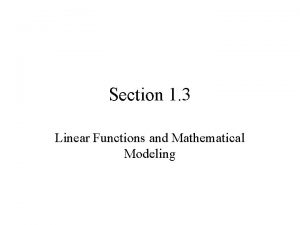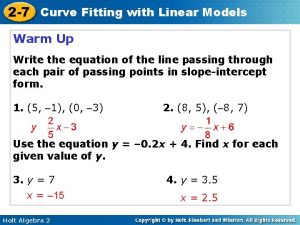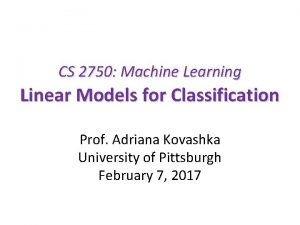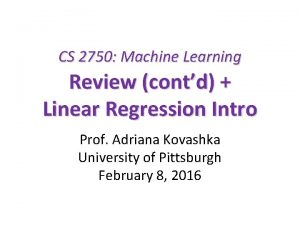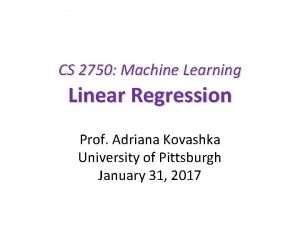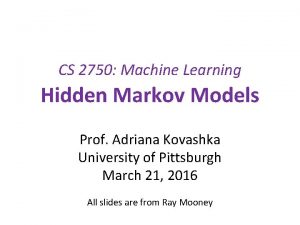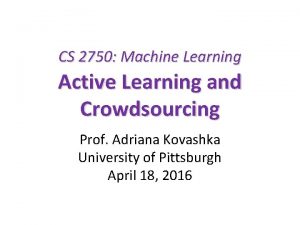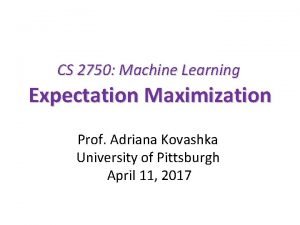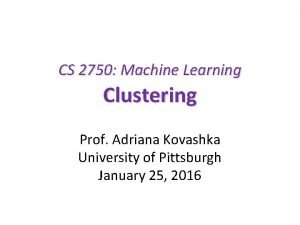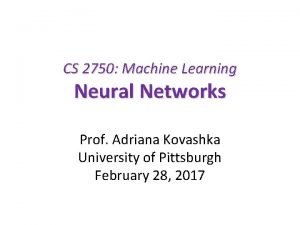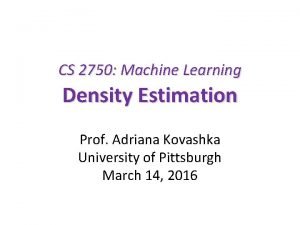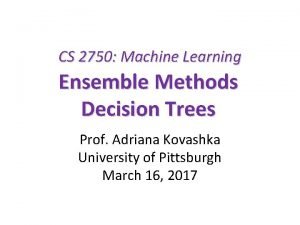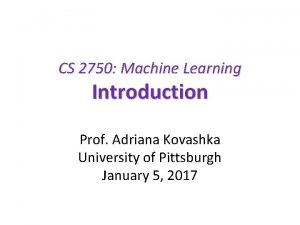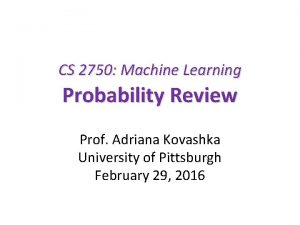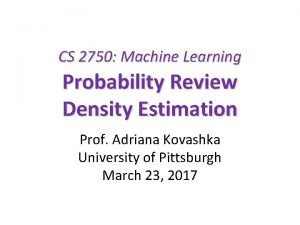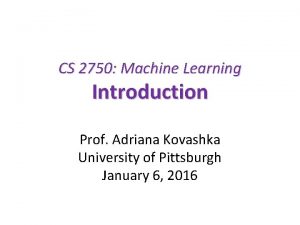CS 2750 Machine Learning Linear Models for Classification















































- Slides: 47

CS 2750: Machine Learning Linear Models for Classification Prof. Adriana Kovashka University of Pittsburgh February 15, 2016

Plan for Today • • • Regression for classification Fisher’s linear discriminant Perceptron Logistic regression Multi-way classification Generative vs discriminative models





The effect of outliers Magenta = least squares, green = logistic regression Figures from Bishop

With three classes Left = least squares, right = logistic regression Figures from Bishop







Fisher’s linear discriminant Figures from Bishop

Plan for Today • • • Regression for classification Fisher’s linear discriminant Perceptron Logistic regression Multi-way classification Generative vs discriminative models

The perceptron algorithm • Rosenblatt (1962) • Prediction rule: where • Loss: (just using the Misclassified examples)

The perceptron algorithm • Loss: • Learning algorithm update rule: • Interpretation: – If sample is being misclassified, make the weight vector more like it

The perceptron algorithm Figures from Bishop

Plan for Today • • • Regression for classification Fisher’s linear discriminant Perceptron Logistic regression Multi-way classification Generative vs discriminative models










Maximum Likelihood Estimation (MLE) u We have a probabilistic model, M, of some phenomena, but we do not know its parameters, . u Each “execution” of M produces an observation, x[i] , according to the (unknown) distribution induced by M. u Goal: After observing x[1] , …, x[n], estimate the model parameters, , that generated the observed data. u This vector parameter can be used to predict future data. u MLE Principle: Choose parameters that maximize the likelihood of the data Adapted from Nir Friedman

Maximum Likelihood Estimation (MLE) u The likelihood of the observed data, given the model parameters , is the conditional probability that the model, M, with parameters , produces x[1] , …, x[n]. L( )=Pr(x[1] , …, x[n] | , M), u In MLE we seek the model parameters, , that maximize the likelihood. Adapted from Nir Friedman

Example: Binomial Experiment u When tossed, it can land in one of two positions: Head (H) or Tail (T) u. We denote by the (unknown) probability P(H). Estimation task: u Given a sequence of toss samples x[1], x[2], …, x[M] we want to estimate the probabilities P(H)= and P(T) = 1 - Adapted from Nir Friedman

The Likelihood Function u How good is a particular ? It depends on how likely it is to generate the observed data u The likelihood for the sequence H, T, T, H, H is u Taking derivative and equating it to 0, we get Adapted from Nir Friedman

Issues u Overconfidence u Better: Maximum-a-posteriori (MAP)

Plan for Today • • • Regression for classification Fisher’s linear discriminant Perceptron Logistic regression Multi-way classification Generative vs discriminative models

Multi-class problems • Instead of just two classes, we now have C classes • E. g. predict which movie genre a viewer likes best • Possible answers: action, drama, indie, thriller, etc. • Two approaches: – One-vs-all – One-vs-one

Multi-class problems • One-vs-all (a. k. a. one-vs-others) – Train K classifiers – In each, pos = data from class i, neg = data from classes other than i – The class with the most confident prediction wins – Example: • • • You have 4 classes, train 4 classifiers 1 vs others: score 3. 5 2 vs others: score 6. 2 3 vs others: score 1. 4 4 vs other: score 5. 5 Final prediction: class 2 – Issues?

Multi-class problems • One-vs-one (a. k. a. all-vs-all) – Train K(K-1)/2 binary classifiers (all pairs of classes) – They all vote for the label – Example: • • You have 4 classes, then train 6 classifiers 1 vs 2, 1 vs 3, 1 vs 4, 2 vs 3, 2 vs 4, 3 vs 4 Votes: 1, 1, 4, 2, 4, 4 Final prediction is class 4

Multi-class problems • What are some problems with this approach to doing multi-class? – There are “natively multi-class” methods Figures from Bishop

Plan for Today • • • Regression for classification Fisher’s linear discriminant Perceptron Logistic regression Multi-way classification Generative vs discriminative models

Generative models • Binary case:

Generative models • Mutli-class case:

Generative models • Why are these called generative? • Can use them to generate new samples x • Perhaps this is overkill?




 2750-1500
2750-1500 Asme 2750 furnaces
Asme 2750 furnaces Gerard schuster
Gerard schuster Geometric models in machine learning
Geometric models in machine learning Stealing machine learning models via prediction apis
Stealing machine learning models via prediction apis Stealing machine learning models via prediction apis
Stealing machine learning models via prediction apis Andrew ng linear regression
Andrew ng linear regression Linear regression with multiple features
Linear regression with multiple features Linear regression with multiple variables machine learning
Linear regression with multiple variables machine learning Product classification machine learning
Product classification machine learning Classification machine learning
Classification machine learning Concept learning task in machine learning
Concept learning task in machine learning Analytical learning in machine learning
Analytical learning in machine learning Pac learning model in machine learning
Pac learning model in machine learning Machine learning t mitchell
Machine learning t mitchell Inductive and analytical learning in machine learning
Inductive and analytical learning in machine learning Inductive and analytical learning problem
Inductive and analytical learning problem Instance based learning in machine learning
Instance based learning in machine learning Inductive learning machine learning
Inductive learning machine learning First order rule learning in machine learning
First order rule learning in machine learning Eager learner vs lazy learner
Eager learner vs lazy learner Cmu machine learning
Cmu machine learning Difference between models and semi modals
Difference between models and semi modals Cuadro comparativo e-learning y b-learning
Cuadro comparativo e-learning y b-learning Thorsten brants
Thorsten brants Both the linear and interactive communication models
Both the linear and interactive communication models Deliberation model of curriculum development
Deliberation model of curriculum development Linear models and rates of change
Linear models and rates of change Communication models examples
Communication models examples A unifying review of linear gaussian models
A unifying review of linear gaussian models Linear basis function models
Linear basis function models Subcripted
Subcripted Linear programming models: graphical and computer methods
Linear programming models: graphical and computer methods Curve fitting with linear models
Curve fitting with linear models Linear functions as mathematical models
Linear functions as mathematical models Linear quadratic and exponential graphs
Linear quadratic and exponential graphs Linear functions as mathematical models
Linear functions as mathematical models Curve fitting with linear models
Curve fitting with linear models Fspos vägledning för kontinuitetshantering
Fspos vägledning för kontinuitetshantering Novell typiska drag
Novell typiska drag Tack för att ni lyssnade bild
Tack för att ni lyssnade bild Vad står k.r.å.k.a.n för
Vad står k.r.å.k.a.n för Shingelfrisyren
Shingelfrisyren En lathund för arbete med kontinuitetshantering
En lathund för arbete med kontinuitetshantering Särskild löneskatt för pensionskostnader
Särskild löneskatt för pensionskostnader Personlig tidbok fylla i
Personlig tidbok fylla i A gastrica
A gastrica Förklara densitet för barn
Förklara densitet för barn



